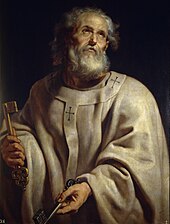


The Keys of Heaven, also called Saint Peter's keys, refers to the metaphorical keys of the office of Saint Peter, the keys of Heaven, or the keys of the kingdom of Heaven. It is explicitly referenced in the Bible in Matthew 16:19.

According to Catholic teaching,[1] Jesus promised the keys to heaven to Saint Peter, empowering him to take binding actions.[2] In the Gospel of Matthew 16:19,[3] Jesus says to Peter, "I will give you the keys of the kingdom of heaven, and whatever you bind on Earth shall be bound in heaven, and whatever you loose on Earth shall be loosed in heaven." Saint Peter is often depicted in Catholic and Eastern Orthodox paintings and other artwork as holding a key or a set of keys.
The keys of heaven or keys of Saint Peter are seen as a symbol of papal authority and are seen on papal coats of arms (those of individual popes) and those of the Holy See and Vatican City State: "Behold he [Peter] received the keys of the kingdom of heaven, the power of binding and loosing is committed to him, the care of the whole Church and its government is given to him".[4]
Bible verses associated with Peter[5][6] and his position of authority include:
Bible verses associated with the transfer of powers from pope to pope include:

|
| |||||
|---|---|---|---|---|---|
Episcopate of the bishopofRome | |||||
| Jurisdiction |
| ||||
| Headquarters |
| ||||
| Major basilicas |
| ||||
| Titles Papal names |
| ||||
| Symbols |
| ||||
| Proclamations |
| ||||
| Activities |
| ||||
| Vestments |
| ||||
| Transportation |
| ||||
| Household |
| ||||
| Staff |
| ||||
| Related |
| ||||
| |||||
|
| |||||||||||
|---|---|---|---|---|---|---|---|---|---|---|---|
| |||||||||||
| History |
| ||||||||||
| Geography |
| ||||||||||
| Politics |
| ||||||||||
| Economy |
| ||||||||||
| Culture |
| ||||||||||
| Sports |
| ||||||||||
| |||||||||||